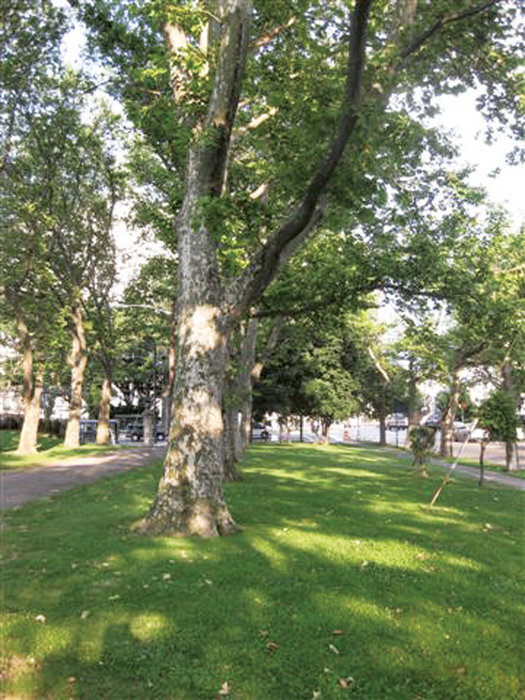Washington Park is having a bit of an identity crisis.
Part of it lies in Jersey City Heights, part of it is leased to Union City, and all of it is owned by Hudson County. It currently has the attention of residents, city officials, a neighborhood association and a nonprofit organization known as the Washington Park Association (WPA).
Stretching approximately four square city blocks from Central Avenue to the South Wing Viaduct, it has four sports fields, several playgrounds, two gazebos, a dog run, and, according to Union City residents Tony Squire and Judy Stone, 51 mature Sycamore trees planted in 1932.
The trees lie in the part of the park known as Block 3, surrounded by Palisade and New York avenues, Paterson Plank Road, and Second Street.
The average life span of an American Sycamore is thought to be between 500 and 600 years.
“There is a plan to expand the baseball field in Block 3 in such a way that almost all of 51 mature trees surrounding it would be taken down,” said Stone, who is the chair of the Union City Neighborhood Association. “The open space that exists where the trees are won’t be completely obliterated, but it will be significantly reduced.”
Coming to a compromise
Union City Mayor Brian Stack said, “We are short of athletic fields, and this one will be a multipurpose field for children to play soccer, baseball, and football. There will be no more pavement in the park. It will be either porous or pavers or bluestone alongside community gardens, including a passive area, and everyone will have access to it.”
But Stone believes the city has an adequate number of fields. She said children have access to the field next to Jose Marti Freshman Academy and on top of the high school, and the preexisting field in Block 3 gets plenty of use.
“We’ve been astounded at the degree of heartfelt feeling and reverence for these mature Sycamore trees.” – Judy Stone
____________
Two years ago the WPA caught wind of the plan to expand the baseball field, when Union City’s Open Space grant applications were reviewed. Having watched over the park since 2008, they brought their concerns to Stack and began to work together on the project.
Peter Basso of the WPA was pleased with the result, even if other members are still concerned about the trees.
“One compromise resulted in the field being shifted toward the non-residential side of the plot [toward Paterson Plank Road],” Basso said, “thus preserving the passive space on Second Street and leaving the existing old trees and tree canopy there for the residents’ enjoyment. We are very happy with this result.”
He added that the Palisade Avenue side, which currently has no trees, will be planted according to the park’s field plans. Discussions have been had about the potential for lining both sides of the avenue with flowering trees.
“In other words, while old tree canopies will come down with the field construction and we’re sad to see some of them go, new field canopies will be planted and mature over time,” Basso added.
He also mentioned that to mitigate other environmental impacts of the field, they will incorporate an underground water collection system that will recycle water to the park.
The sycamore issue
“We’ve done an enormous amount of canvassing in the surrounding neighborhoods,” Stone said, “And we’ve been astounded at the degree of heartfelt feeling and reverence for these mature Sycamore trees. It’s enormous.”
The Sycamores along Second Street create a shady canopy over passive space that can be seen from Google Earth, and they also serve as wind breaks when storms pass over the area, Stone explained.
Squire has taken a personal inventory of the trees and has found that a few of their circumferences measure 9.5 feet, which is very rare, he said.
“The most recent information suggests that most of the trees will be removed,” Squire said, which would leave nine, but one shows signs of decay and will most likely have to be taken down.
Stack, who has already had 15 meetings about the park’s development and has worked closely with the WPA over the years during the planning stages, said that only 26 trees would be removed, and that many of them are dead.
Basso agreed with Stack.
“I’m not comfortable with Judy [Stone]’s count of the [51] trees because it masks the fact that a significant number of those trees need to come down regardless of construction,” Basso said, “Whether due to disease or [a utility company’s] butchering them over the years to avoid the power lines.”
The trees that are removed will be replaced by between 200 and 300 new trees and extensive landscaping along Palisade Avenue, Stack said.
“I love trees,” he added. “There are trees on every city block we pave, and the ones going into the park are not the young skinny ones, but the larger mature trees.”
“Nearby residents have been unanimously opposed to the destruction of this tree canopy,” Stone said. “It is ironic that the open space that gets used on a daily basis by children, teenagers, and their families will be removed if this project goes forward.”
Moving ahead
“I feel the Washington Park Association’s interest is development oriented,” Stone said. “One of our main points is that there has been no public input from the residents either of Jersey City or Union City.”
Both Stack and Basso said that there will in fact be public meetings held some time in September regarding the development of the park, as many residents are on vacation in the summer.
Stack added that the park’s overhaul will require $300,000 in grant money, and is projected to begin at the end of the year.
For more information on the Union City Neighborhood Association, visit ucneighbors.net. For more information on the WPA, visit wpanj.org.
Gennarose Pope may be reached at gpope@hudsonreporter.com
